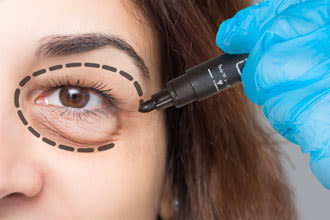Oculoplasty surgery is generally safe and effective, but like any surgical procedure, it carries potential risks and complications. These can vary depending on the specific type of oculoplasty surgery and the individual patient’s health. It’s important to discuss these risks with your oculoplastic surgeon before the procedure. Some potential risks and complications of oculoplasty surgery may include:
- Infection: Surgical site infections can occur, leading to redness, swelling, pain, and discharge. Prompt treatment with antibiotics is essential to prevent complications.
- Scarring: Scarring is a possibility after any surgery. Oculoplastic surgeons aim to minimize scarring by placing incisions in inconspicuous locations, but the extent of scarring can vary from person to person.
- Bleeding: While post-operative bleeding is relatively rare, it can occur. Excessive bleeding may require intervention to control and address the cause.
- Asymmetry: Achieving perfect symmetry in oculoplasty procedures can be challenging. In some cases, slight differences in appearance between the eyes may persist after surgery.
- Under-correction or Over-correction: Procedures to correct eyelid issues, like ptosis or ectropion, may result in under-correction (the problem remains) or over-correction (excessive correction) and require revision surgery.
- Double Vision: After eyelid surgery, some patients may experience double vision due to changes in eye alignment. This is usually temporary but may require treatment.
- Dry Eyes: Tear duct surgery or eyelid procedures can affect tear production or drainage, leading to temporary or, in rare cases, long-term dry eyes.
- Changes in Eye Shape or Function: Eyelid surgery can alter the shape and function of the eyelids. In some instances, it may affect blink patterns or eyelid closure.
- Visual Changes: In some cases, there may be temporary or permanent visual changes, such as blurriness or visual disturbances, especially if the eye’s position is altered.
- Anesthesia Complications: Allergic reactions or adverse effects related to anesthesia are possible but rare.
- Injury to Eye Structures: While uncommon, oculoplasty surgery can potentially lead to injury of eye structures like the cornea, lens, or retina.
- Inadequate Results: The outcome of oculoplasty surgery may not always meet the patient’s expectations or the surgeon’s goals, and additional procedures may be necessary.
- Intraocular Pressure Changes: Certain eyelid procedures can influence intraocular pressure, potentially affecting patients with glaucoma.
It’s crucial to choose a qualified and experienced oculoplastic surgeon and thoroughly discuss your expectations, potential risks, and complications before undergoing any oculoplasty procedure. Your surgeon will provide personalized guidance, pre-operative instructions, and post-operative care to minimize these risks and ensure the best possible outcome.
For More information, contact Dr. Bipin Shah, Ophthalmologist in Matunga. Visit Shanta Medical Centre Charitable medical trust in Mumbai.



